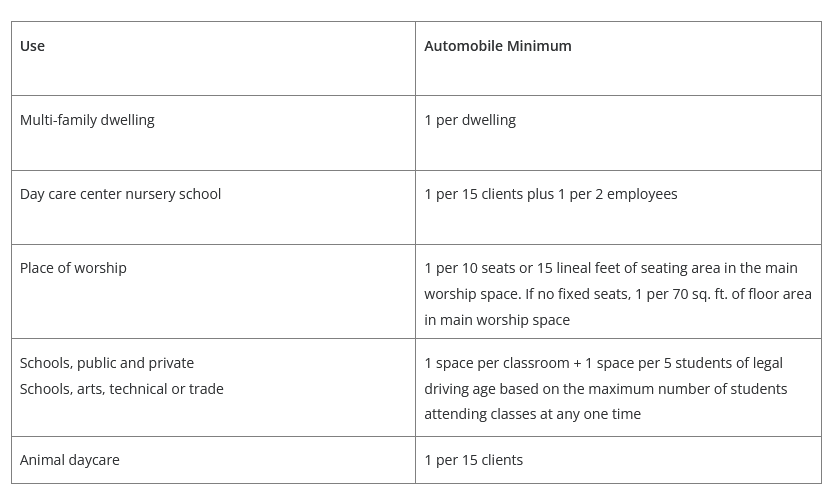Parking Mandates: please end them
It was worth reading 600 pages of a parking textbook to understand why
Madison has started to talk about parking mandates. Or maybe it’s just our Strong Towns Local Conversation. In any case, this is important to me because these rules do not make sense and they should not be on our books.
What is a parking mandate?
It’s a rule, traditionally based on poor data, mandating that certain land uses adhere to a minimum number of parking spaces. They’re found in Subchapter 28I: General Regulations in section 28.141 - Parking Loading and Standards. Madison, like many cities across the United States, has adopted reforms to remove parking minimums from the Central District and other zoning ordinances (certain mixed-use districts, the Transit Oriented District (TOD) overlay district). However, for residential and commercial properties not located in these areas there are still parking minimums. Here are some examples:
The two questions1 these make me ask are:
How did we determine these were the right parking minimums?
Why do we require more parking when places grow?
I don’t think we have good answers for either. If someone wants to help me understand how the government determined that animal daycares require a spot per 15 clients but a normal day care requires that in addition too the spot per 2 employees, I’ll gladly review it. It’s also possible that the animal daycare exists in the commercial space of a Neighborhood Mixed-Use apartment building that has over 10,000 sqft of floor space (kicking in parking minimums). If the residents (and their dogs) decide they really like the place, and the business expands to the next-door vacant space to account for increased demand, do they need to construct additional parking spaces? The residents are in the building, they aren’t parking for the business!
Businesses and homes exist in different locations and contexts and I think it’s impossible for a local government to efficiently determine the right number of parking spaces through a code that looks like this.
The “right” number of minimum parking spaces
These parking minimums were copied and pasted into city ordinances across the U.S based on some studies performed by the Institute of Transportation Engineers (ITE). In Donald Shoup’s “The High Cost of Free Parking”, an entire chapter is dedicated to refuting the analysis performed by the ITE. As someone who last took a statistics course nearly 5 years ago, it still doesn’t take much to see how poorly the data was interpreted. I believe I audibly gasped the first time I saw the trend lines.
That is not a fair trend line! Look at the R-squared value: .038 (1 means a perfect linear trend). This graph is showing the number of occupied parking spaces compared to the square footage of a fast food restaurant. It implies that larger area restaurants require more parking spaces to allow people to have available parking.
It has nothing to do with the quality or location of the restaurant
There are simultaneously two 2,500 sqft restaurants that have 43 and 16 occupied parking spots
The largest restaurant is the median parking occupancy but would need to 1.5x their current occupancy to meet the new required minimum standard
This is bad policy because the data is flawed. Parking spots are also expensive; this bad policy has serious ramifications. Shoup used Rider Levett Bucknall (RLB), a consulting company that estimates construction costs, to estimate costs in Seattle back in the late 90’s. Using the RLB Intelligence Construction Cost Indicator, we can find values that are based on 2024 dollars and in a region closer to us, Chicago. The calculator provides low and high values for ground and basement construction. Victoria Transport Policy Institute (VTPI) puts off-street parking spots as requiring between 300 and 400 square feet per car.2
For a hypothetical 100 car garage in Chicago, here are the cheapest3 and most expensive scenarios:
It is in a developer or businesses’ best interest to know how much parking they will need. If you don’t have enough parking, customers or tenants get very frustrated. But if you have too much, you are wasting a lot of money. That money either prevents you from starting the project, expanding the project, or forcing your customers/tenants to pay more to cover the expense. The right number of minimum spots is the one that balances convenience with cost.
How do developers behave when parking minimums are removed? In Buffalo and Seattle, nearly 50% of projects post-parking reform used less parking than was previously required. In the Buffalo study they concluded:
On average, each development introduced 60 fewer parking spaces than previously required at minimum. The considerable range in differences (2–168 fewer parking spaces than previously required) suggests certain projects benefited substantially from the ability to provide less off-street parking following the code reform
Some businesses added additional parking than what was required. Hess and Rehler say it best when they note the benefits of flexibility. This is why Madison should remove parking mandates. We should let the experts (based on their bottom line) determine the minimum amount of parking they need.
Not on my neighborhood street
The strongest (emotional) argument against removing parking mandates is the exploitation of on-street free parking around the City. At several Plan Commission and developer meetings I’ve attended, residents in the neighborhood raised concerns about renters parking cars in nearby on-street parking. The complaints typically center around:
Convenience/ownership: this public street in front of my house is my parking spot* (*not legally) and either myself or my family/friends should be able to park there whenever without hassle
Congestion: more cars means more traffic and that makes it more difficult for me to drive
Change: this wasn’t the way things were before and I don’t like that
All opinions I probably can’t refute, because they tend to be deeply held. I think it’s worth exploring what keeping the parking mandates as is means though:
Less housing gets built, either by fewer units (to account for the needed parking) or by not being built at all as the project cannot pencil out
This means less revenue for the City, as Madison relies on 70% of it’s revenue from property taxes. The remaining residents will experience higher taxes or worse service from budget cuts
It also pushes people who work in Madison to commute from homes outside of Madison. These people driving over 30 minutes (and probably closer to an hour) will need parking spots. The same parking spots that are expensive and require lots of land. That will need to be paid for.
The housing that does get built has more parking spots than are used
Asphalt is ugly and we should try to reduce this when possible
Parking spots are a sunk cost and the payment for those costs will come from higher rents or goods/services
The efficient answer that these neighbors are looking for is better enforcement of on-street parking. But that will also come with costs, because the land is valuable and the enforcement isn’t cheap. If the spot is free, people will park there. The alternative is to start charging for parking, which gives up the convenience4 of the spot to the homeowners. My recommendation would be to develop a Parking Benefit District where the community receives the majority of the revenue and can spend it on what they desire for their neighborhood. That could be sidewalks, more night patrols, or even well-funded block parties. It’s (mostly) your money, have fun with it! You could also send it back to the General Fund but that’s less fun and I think it’s worthwhile for the City to compromise for the loss of convenience.
Can Madison end parking mandates?
Yes. Unequivocally yes. They’ve been ended in the Central District and other zoning districts already. Some will argue that this where parking mandates matter the most, so why bother removing the rest? As we move into smaller development areas, the costs of parking will become more acute. Small businesses and developers are not going to have the spare capital to handle needing several more spots that won’t be used.
It’s a bad policy for all parts of the City and it should be removed. Mandates restrict housing and raise costs for no benefit (these spaces are not used, in a world without mandates the buildings that do need more parking can still build those parking spots).
We won’t be the first. The Parking Reform Network has a Mandates Map indicating which localities have removed their parking mandates entirely. Cities from Gold Hill, OR (population 1,335) to Austin, TX (population 974,447) have decided the benefits are worth their removal. Even Minnesota as a state is looking to preempt cities and prevent them from imposing parking minimums. We should get on board and start to see the benefits.
…
One last note: if you want to learn more about parking and how important it is in U.S society, but you don’t want to read a textbook, you should check-out “Paved Paradise: How Parking Explains the World” by Henry Grabar.
Okay a third: do inspectors carry tape measures to count the amount of lineal feet of seating in a place of worship to ensure parking minimums are appropriately accounted for? Probably.
Although the typical parking spot requires a little less than 200 square feet, the access roads and maneuverability within the parking lot/garage requires more space.
I was shocked by the cheapest option, I know inflation is bad but Shoup and VTPI both put cheaper surface level lots at closer to $10,000/spot.
A convenience they are paying for in property taxes. Parking is not free. That street has to be maintained.





